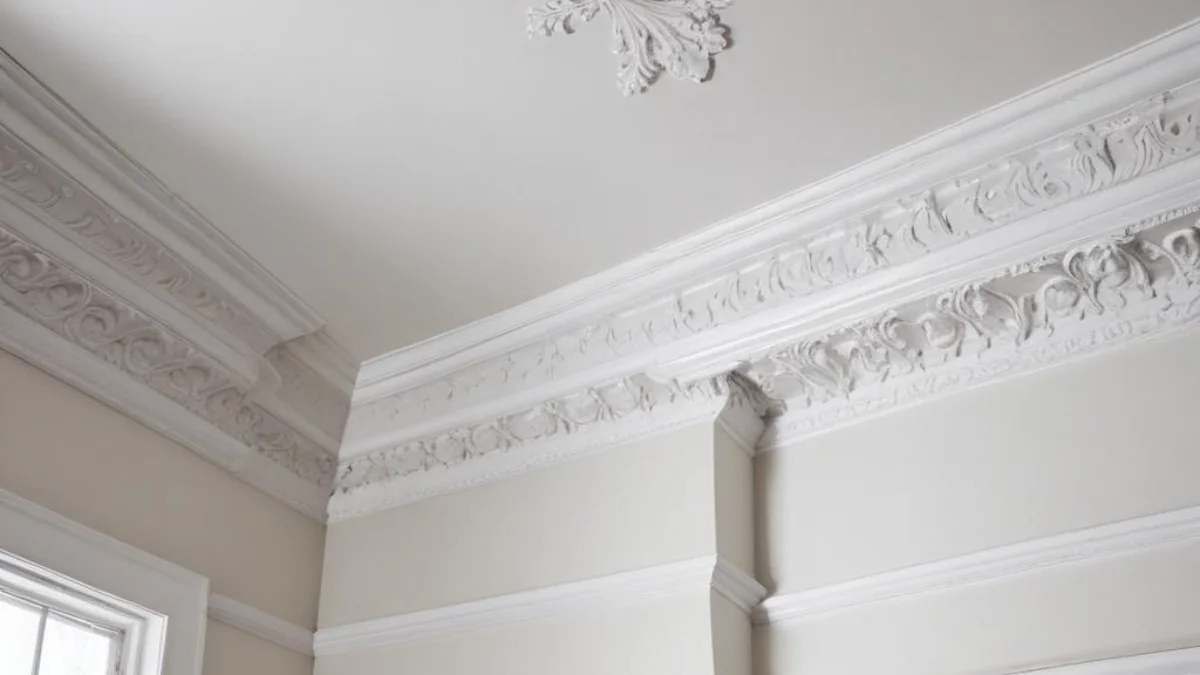How to Fix Crown Molding Separating from Ceiling: Easy Fix
Crown molding adds a touch of elegance to any room, creating a seamless transition between walls and ceiling. But what happens when that seamless look is interrupted by an unsightly gap? Crown molding separating from the ceiling is a frustratingly common problem for homeowners. It can detract from the beauty of your space and may even signal underlying issues.
This comprehensive guide will walk you through everything you need to know about fixing this issue. We’ll explore the root causes of separation, provide a detailed step-by-step repair process, and offer tips to prevent it from happening again. You’ll gain the confidence to tackle this project and restore your crown molding to its original glory.
You'll Learn About
Why Is My Crown Molding Pulling Away From the Ceiling?
Understanding the cause of the separation is the first step toward a lasting fix. Several factors can contribute to this problem, ranging from environmental changes to installation errors. Identifying the specific reason will help you choose the right repair method.
Truss Uplift and Structural Shifts
One of the most common culprits, especially in colder climates, is something called “truss uplift.” Roof trusses, the structural framework of your roof, can expand and contract with seasonal changes in temperature and humidity. During winter, the cold, dry air in the attic can cause the top chords of the trusses to contract and lift, pulling the ceiling up with them while the interior walls stay put.
This movement creates a gap between the ceiling and the crown molding. This is a natural occurrence in many homes and doesn’t necessarily indicate a severe structural problem. Minor house settling can also cause small shifts that lead to gaps over time.
Humidity and Temperature Fluctuations
Wood is a hygroscopic material, meaning it absorbs and releases moisture from the air. As humidity levels change, wood expands and contracts. This is a significant factor for wood crown molding. In humid summer months, the wood swells, and in the dry winter, it shrinks.
These constant changes can stress the joints and fasteners, causing the molding to pull away from the wall or ceiling. If you notice the gap is more prominent during certain seasons, humidity is likely a major contributor. Maintaining a consistent indoor climate can help minimize these effects.
Improper Installation
Sometimes, the problem dates back to the initial installation. If the crown molding wasn’t securely fastened to both the wall studs and the ceiling joists, it’s more likely to separate. An installer might have used nails that were too short or failed to hit solid framing members, relying only on drywall for support.
Additionally, if low-quality or inflexible caulk was used to fill the initial gaps, it can dry out, shrink, and crack over time, revealing the separation. For long-term stability, it’s crucial that molding is attached to the structural elements of the house.
Tools and Materials for Your Crown Molding Repair
Before you begin, gathering the right tools and materials will make the job smoother and ensure a professional-looking result. You may not need everything on this list, depending on the severity of the gap and your chosen repair method.

Essential Supplies:
- Caulking Gun: For applying caulk or sealant.
- Flexible, Paintable Caulk: Look for products labeled “elastomeric” or “big stretch” that can handle movement.
- Utility Knife: To cut away old, failed caulk.
- Putty Knife: For applying filler and smoothing surfaces.
- Wood Filler or Spackle: For filling nail holes and larger imperfections.
- Fine-Grit Sandpaper (150-220 grit): To smooth dried filler.
- Painter’s Tape: To create clean caulk lines and protect surfaces.
- Primer and Paint: To match your existing molding and ceiling colors.
- Drop Cloths: To protect your floors and furniture.
For More Secure Repairs:
- Stud Finder: To locate wall studs and ceiling joists.
- Nail Gun (Brad Nailer or Finish Nailer): For securing the molding.
- Finishing Nails: Ensure they are long enough to penetrate the drywall and go into the framing.
- Nail Set: To countersink nail heads below the surface.
Step-by-Step Guide to Fixing the Gap
With your tools ready, you can now begin the repair. This process is straightforward, but taking your time and paying attention to detail will yield the best results. For a small, seasonal gap, you may only need to re-caulk. For larger, more persistent gaps, re-securing the molding is recommended.
Step 1: Prepare the Area
Start by clearing the area below the crown molding. Lay down drop cloths to protect your flooring and any nearby furniture. Use a sturdy ladder to safely reach the molding.
Next, carefully inspect the gap. Use a utility knife to cut away any old, cracked, or peeling caulk from the joint. Scrape away any loose debris with a putty knife to ensure the new caulk will have a clean surface to adhere to.
Step 2: Re-secure the Molding (If Necessary)
For gaps larger than 1/8 of an inch or if the molding feels loose, you should re-secure it. Use a stud finder to locate the wall studs and ceiling joists along the length of the separated molding. Mark their locations lightly with a pencil.
Press the crown molding firmly back into place against both the wall and ceiling. Using a finish nailer, drive new nails through the molding into the studs and joists you marked. Angle the nails for a stronger hold. If you don’t have a nailer, you can use a hammer and finishing nails, but be sure to use a nail set to sink the heads slightly below the wood surface.
Step 3: Fill the Gaps and Nail Holes
Now it’s time to conceal the gap and any new nail holes. For very small gaps (less than 1/4 inch), a high-quality, flexible caulk is your best bet. For larger gaps, you might first consider pushing a foam backer rod into the space to provide support for the caulk.
Apply a continuous bead of paintable, elastomeric caulk along the entire length of the gap. Use a wet finger or a caulk-smoothing tool to press the bead into the joint, creating a smooth, concave line. Wipe away any excess caulk immediately with a damp rag.
Use a small amount of spackle or wood filler on a putty knife to fill any nail holes. Overfill them slightly to account for shrinkage as they dry. Once the filler is completely dry, lightly sand it smooth with fine-grit sandpaper.
Step 4: Prime and Paint for a Flawless Finish
After the caulk and filler have fully cured (check the manufacturer’s instructions), the final step is to make the repair invisible. Apply a coat of primer over the new caulk and filled nail holes. This step is crucial because it prevents the paint from flashing (appearing different in sheen) and ensures the caulk accepts the paint evenly.
Once the primer is dry, apply your finish paint to match the crown molding. You may also need to touch up the ceiling paint right next to the new caulk line. Using painter’s tape can help you achieve a perfectly straight edge.
Choosing the Right Filler for the Job
The product you choose to fill the gap can make a big difference in the longevity of your repair. Not all fillers are created equal. This table breaks down the common options and their best uses.
| Filler Type | Best For | Flexibility | Key Characteristics |
|---|---|---|---|
| Acrylic Latex Caulk | Small gaps (under 1/4″), seasonal movement | Good | Easy to apply, water cleanup, paintable. Can shrink over time. |
| Elastomeric/Urethane Caulk | Areas with significant movement, larger gaps | Excellent | Highly flexible and durable, less prone to cracking. “Big Stretch” is a popular brand. |
| Spackle/Wood Filler | Nail holes, dents, non-moving cracks | Low | Dries hard, sandable for a very smooth finish. Will crack if used in a joint that moves. |
Preventing Future Separation
Once your crown molding looks perfect again, you’ll want to keep it that way. While you can’t stop your house from shifting, you can take steps to minimize the chances of the gap reappearing.
Control Indoor Humidity
One of the most effective strategies is to maintain a stable indoor environment. Using a humidifier in the dry winter months and a dehumidifier during humid summers can reduce the expansion and contraction of wood molding. This not only protects your trim but is also beneficial for hardwood floors and wooden furniture.
Proper Installation Techniques
If you’re installing new crown molding, ensure it’s done correctly from the start. Always nail the molding into solid wood framing, not just the drywall. Using a combination of construction adhesive and properly sized nails can also create a stronger, more durable bond.
Choose the Right Materials
While wood is traditional, other materials are less susceptible to environmental changes. MDF (Medium-Density Fiberboard) is more stable than solid wood. Polyurethane or PVC moldings are waterproof and completely immune to humidity changes, making them an excellent choice for bathrooms or homes in very humid climates.
Dealing with crown molding that has separated from the ceiling doesn’t have to be a major headache. By understanding the causes and following a methodical repair process, you can easily restore the elegant, finished look of your room. Remember that seasonal movement is normal in many homes, but with the right flexible materials and a little maintenance, your crown molding can look great for years to come.
If you’re dealing with more significant structural issues, such as a noticeable dip in your roofline, you may need to investigate potential solutions for a sagging roof overhang. Learn more about ways to fix sagging roof overhang. For those living in colder regions, it’s also useful to know if certain weather conditions affect other parts of your home, like wondering does snow kill moss on your roof. And for other unique home projects, you might be curious about specialized tasks like installing an electrical outlet inside a fireplace.

